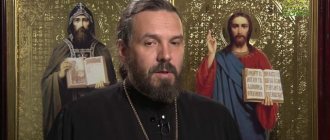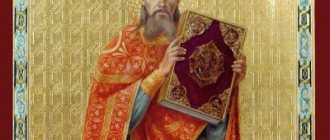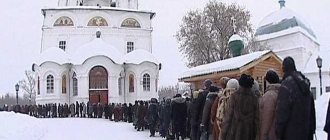It's no secret that luxury and wide financial opportunities have long become an integral element of the life of high-ranking clergy. Many of them seriously believe that you need to be modest only before God, and in worldly life they try not to deny themselves anything. It is not surprising that the clergy’s car park constantly causes heated debate among “mere mortals.”
It is generally accepted that the heads of churches are called to take care of all things spiritual, but, apparently, they are not accustomed to denying themselves worldly pleasures. Clergymen are often seen driving exclusive cars that cost a fortune. Their every appearance in a public place causes mixed reactions from people. Today we decided to talk about what kind of cars famous clergy drive.
Patriarch Kirill and his Cadillac Escalade, Mercedes-Benz S-Class Pullman
In the Russian press you can often find notes about how reverently His Holiness Patriarch Kirill of Moscow and All Rus' treats expensive watches, yachts and cars. At the same time, Patriarch Kirill calls on all Orthodox believers to be more modest in their requests. He calls on ordinary Russians to think less about wealth, because, in his opinion, it is sinful. Such calls in no way prevent the head of the Russian Orthodox Church from traveling exclusively in premium cars.
The patriarch's fleet includes dozens of exclusive cars. In particular, His Holiness the Patriarch often drives a Mercedes-Benz S-Class Pullman, Cadillac Escalade and other G-Class models. True, these luxury cars are not registered to him personally, but are listed on a special balance sheet of the church. As expected
A VIP person, Patriarch Kirill travels exclusively in premium cars. By the way, the head of the Russian Orthodox Church has a great passion not only for SUVs and premium cars, but also for rare cars. From time to time it is seen on the rare Volga model, which was made in the middle of the last century and costs a fortune. It’s really not a shame to come to work in such a car. Most often, Patriarch Kirill can be found driving a Gelendvagen.
The clergyman himself admits that he adores “beautiful chariots.” Almost all the cars in Kirill's fleet are armored. The armor, apparently, was applied according to the principle: “Trust in God, but don’t make a mistake yourself.” In addition to the classic German limousine Mercedes-Benz S-Class Pullman, Kirill can often be found driving a hefty American SUV Cadillac Escalade, of which, by the way, he has two. Probably on the principle that God loves a trinity. As we see, an important church person moves on what God sent. And often with flashing lights.
nefeidmann › Blog › Car for a priest
Another controversy has arisen about cars for priests. As a rule, it all comes down to exactly one thing - how expensive a car can a priest afford? The dispute divides church people into exactly two categories: those who have nothing against (or even for) expensive cars from a hypothetical good priest, and those who are against automobile luxury. At the same time, few people try to clearly formulate the criteria for a “sacred car.” But first things first.
The majority of Orthodox Christians (70% in a recent survey) have nothing against a priest having an expensive car if he is “normal.” The criteria for this normality are not specified; whether a hypothetical “normal” priest can use a frankly expensive car, too. But this worries non-church people very, very much. And here you need to determine several things.
We live in a secular capitalist state in which expensive and very expensive cars are sold, which no one is prohibited from buying. In addition, we have freedom of speech in our country. All this adds up to several points. Nobody forbids clergy to buy or use such expensive cars that they have enough money or benefactors for. No one forbids non-church people from drawing their own, even if incorrect, conclusions from this. Objective fact: a non-church person will see exclusively expensive cars from clergy and from this draw a conclusion about the material well-being of the entire Church. This is where the thesis “Church is a business” comes from. Let me clarify once again - this is an objective phenomenon, it occurs outside of our logical preferences. Such things simply need to be taken into account when creating a “positive image of the Church,” which has recently been increasingly talked about in the church press. Here, perhaps, another clarification is required for the thesis made at the beginning of the paragraph: the majority of Orthodox Christians (read: church Christians) have nothing against an expensive car for a priest.
On the one hand, the number of parishioners among the entire population of the country is less than 1%. On the other hand, it is these fractions of a percent that “feed” the Church. A simple conclusion follows from this: the question of the cost of clergy cars is exclusively missionary in nature. If the Church wants to greatly increase the number of followers of Christ, then the issue of the cost of a car will have to be resolved; this is an objective necessity. But in the daily life of the Church this issue is not pressing.
Now let’s move on to specific “sacred cars”. The essence of this issue is extremely simple - the car must meet the assigned tasks. It must be borne in mind that all considerations of the Office
This is how it turns out that some persons in the priesthood are entrusted with considerable administrative responsibilities. It would be a good idea to do the “ideal” thing, that is, assign all these responsibilities to responsible parishioners. But there are no such responsible parishioners who are ready to undertake such work fully and with full responsibility.
Therefore, for clergy in administrative positions, a comfortable car is objectively necessary: comfortable, with excellent sound insulation, fast. I know situations when clergy of various calibers (from priest to bishop) had to serve in the morning and evening in different parts of their native land, while some business issues could not be transferred, and they were resolved “on the road.” Here, in general, you need not only a car, but also a driver for it. And let the subordinates worry about the high cost of the “filling” of this car. Personally, I am strictly for the quality of the workplace, which, alas, is never cheap.
Many priests are fathers of many children. In addition, there is often a parish need to transport clergy or parishioners. Therefore, the purchase of a minibus or multi-seat minivan is inevitable for some. Such a car is by definition expensive. Even the domestic manufacturer offers only Sobol and Largus among the multi-seat B-variants, which are significantly more expensive than other passenger cars. But if the nth number of parishioners constantly travel in this car, it is unlikely that anyone will have any complaints. And if the comfort of this car is accessible to “mere mortals,” then even the top model will not cause any complaints.
Patriarch Filaret and Mercedes-Benz S600
In the case of Ukrainian clergy of the highest ranks, the situation is similar. The head of the Ukrainian Orthodox Church, Filaret, also insists that in worldly life one must be modest and humbly endure all hardships. True, Filaret himself is in no hurry to fulfill his commandments. It can often be seen in the interior of the Mercedes-Benz S600 - the legendary “six hundredth Mercedes” with trump numbers “777”. According to Filaret, this car was presented to him as a gift by an unknown benefactor back in 2007.
By the way, this is not the only vehicle that is listed in his garage. There are several more luxury cars in his fleet. Moreover, Patriarch Filaret is even the owner of several Iveco cargo-passenger buses. The priest claims that they are all used for the benefit of the diocese, but he himself does not have a private life, as such.
In the service of God: what do the richest church ministers drive?
It's no secret that luxury and wide financial opportunities have long become an integral element of the life of high-ranking clergy. Many of them seriously believe that you need to be modest only before God, and in worldly life they try not to deny themselves anything. It is not surprising that the clergy’s car park constantly causes heated debate among “mere mortals.”
It is generally accepted that the heads of churches are called to take care of all things spiritual, but, apparently, they are not accustomed to denying themselves worldly pleasures. Clergymen are often seen driving exclusive cars that cost a fortune. Their every appearance in a public place causes mixed reactions from people. Today we decided to talk about what kind of cars famous clergy drive.
The rector of the Kiev Pechersk Lavra, Metropolitan Pavel and Lexus
Metropolitan Pavel drives a Lexus, which, in his own words, was given to him for his birthday by close friends.
Occasionally it can be found on an extended Mercedes-Benz. S 500 4Matic. This, of course, is not a limousine, but it’s also not bad.
How do people become priests in Russia?
An important condition for becoming a priest is marriage and ordination. If this is not done, then after training the seminarian will be enrolled as a reader. As a rule, they are sent to the cities from which they came. The salary of readers is small, and let’s say in Moscow, it fluctuates around 20 thousand rubles.
Before becoming a priest, a former seminarian must serve as a deacon for several years. At this time, he helps the priest and bishop perform the service, but do not have the right to conduct any of the seven Sacraments.
It is noteworthy that, just like doctors and teachers, clergy are susceptible to internal burnout. As a rule, this happens due to a large flow of people. They come to church with their troubles, tears, grief. The clergy, one way or another, become immersed in their difficulties, and this leads to an increase in irritation, apathy, and sometimes it is very difficult to regain their strength.
Metropolitan Pavel of Minsk and Slutsk and BMW 7 Series
The Metropolitan of Minsk's fleet includes a BMW 7 Series. In addition, he has a brand new Range Rover in his garage, which he likes to drive to special events. Apparently, Metropolitan Pavel, unlike his colleagues in the Russian Orthodox Church, is not a big fan of black premium Mercedes. He loves his snow-white BMW 7 Series, and would never trade it for a 600 Mercedes.
It is curious that the love for the “seven” was inherited by Metropolitan Paul from his predecessor Philaret. Subsequently, exactly the same one appeared in the garage of a Minsk clergyman. However, Metropolitan Pavel did not stop there. By the will of the Lord, the legendary British stallion, Land Rover Range Rover, appeared in his garage. Moreover, on Russian numbers.
The stereotype that all priests drive expensive cars
In the modern world, with the help of the media and the Internet, “butts in Mercedes”, “gold watches”, vacations in foreign resorts, etc. are created. Perhaps this also applies to rectors of large urban Moscow churches and deans, but their number does not exceed 3% of the total number of priests. The rest of them live quite modestly.
People become priests for various reasons. Some choose this lifestyle because they have a priest father and can count on a place in a large parish. But many choose this path out of a desire to serve people and God. And this, perhaps, is the main thing in this profession, since otherwise, the clergy becomes nothing more than a performer of requirements. He can do it well, but without putting his soul into it.
The career of a clergyman begins with training in a seminary. At the same time, it is important not only to pass the entrance exams well, but also to go through a series of interviews, during which teachers get to know the future seminarians.
Pope
The Pope does not hide his fleet of vehicles; the head of the Catholic Church has a fairly large one. The “daddymobile” alone is worth it - a special Mercedes Gelendvagen vehicle. The company has built more than one such car especially for the Pope.
In addition to the “popemobile,” the Catholic leaders’ fleet includes iron “Harleys,” vintage “Ferraris,” “Cadillac Deville,” and even a “Fiat Ducato” minibus.
What part-time jobs do priests have?
In Russia there is such a thing as private requirements. This basically means the consecration of an apartment, car, and communion at home. This is the activity of a clergyman outside working hours, for which he also receives remuneration from parishioners.
Private demands are also influenced by where the clergyman lives. As a rule, there are more of them in large cities. This is also influenced by how contactable and attentive the clergyman is.
In some regions, the church requires clergy to donate funds received from private services to the benefit of the temple, but in others it does not. Even in seminars, future “priests” are taught that you can’t ask for money for your needs, but if they give it, you don’t have to refuse. Therefore, it is impossible to say exactly how much a clergyman will earn from them. It depends on the parishioner. Some don't give anything at all.
Source
Where do priests live better?
The salary of a church rector depends on the financial capabilities of the parish, and mainly on donations from parishioners. In a big city, the turnover of money in the temple can reach several million. In the provinces this figure is significantly lower.
To meet their needs, churches are also allowed to rent out premises, engage in agriculture, as well as business that does not indulge in such human passions as drunkenness, fornication, and the like. The funds received can be used to repair the church building.
The money from donations is distributed by the abbot. Moreover, each church donates 25% of all its income to the diocese, and there are also quarterly contributions that increase every year.
It is noteworthy that if the abbot does not fulfill the plan for the allocation of funds, he may lose his position. Very often, in order not to lose their position and to increase the percentage of contributions, they cut the salaries of church workers.










